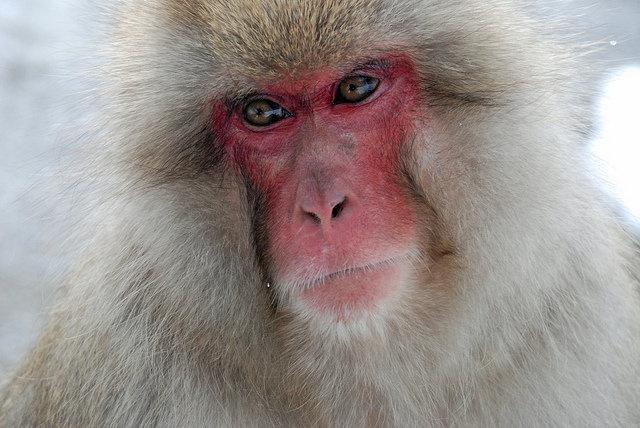
Japanese macaque portrait by Jean-François Chénier
The Japanese macaque is a medium-sized macaque species with an almost naked pink face which is also known to the world as Snow-Monkey. The face of the terrestrial snow-monkey is surrounded by a moderately long, yellowish-brown beard. In Japan, the species is known as Nihonzaru to distinguish it from other primates.

Males weigh on average 11.3 kg (25 lb), while females average 8.4 kg (19 lb). Macaques from colder areas tend to weigh more than ones from warmer areas. Male average height is 570.1 mm (22.44 in) and female average height is 522.8 mm (20.58 in). Japanese macaques have short stumps for tails that average 92.51 mm (3.642 in) in males and 79.08 mm (3.113 in) in females.

A male and female macaque will form a pair bond and mate, feed, rest and travel together, and this typically lasts 1.6 days on average during the mating season. Females enter into consort ships with an average of four males a season. During the mating season, the face and genitalia of males redden and the tail will stand erect. In addition, females’ faces and anogenital regions turn scarlet. Macaques will copulate both on the ground and in the trees. During feeding or moving, Japanese macaques will often emit “coos”. These most likely serve to keep the troop together and strengthen social relations between females.

The Japanese macaque is a very intelligent species. This terrestrial snow-monkey has other unusual behaviors, including bathing together in hot springs and rolling snowballs for fun.Also in recent studies, the Japanese macaque has been found to develop different accents, like humans.Macaques in areas separated by only a few hundred miles can have very different pitches in their calls, their form of communication. The Japanese macaque lives in a variety of habitats. It inhabits subtropical forests in the southern part of its range and subarctic forests in mountainous areas in the northern part of its range. It can be found in both warm and cool forests, such as the deciduous forests of central and northern Japan and the broad leaf evergreen forests in the southwest of the islands.